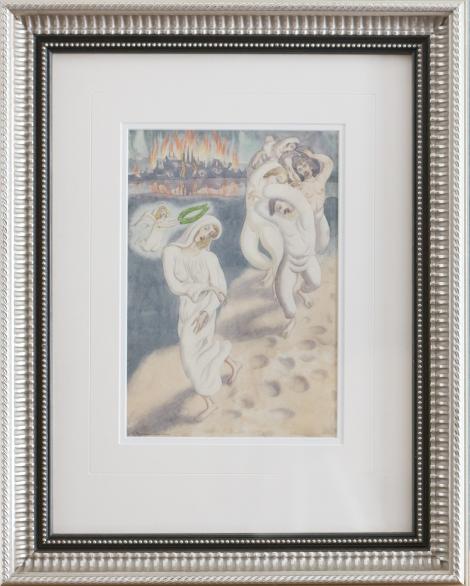Coventry (SOLD)

COVENTRY 14TH NOVEMBER 1940
Watercolour - Signed dated and inscribed
Image Area: 11ins x 7.5ins - Framed: 20.5ins x 16ins
SOLD
Early on in the evening the Cathedral of St Michael was hit. By only 7.40, despite valiant efforts, its defenders had succumbed to the incendiary barrage and the roof began to burn. At 7.59 every available fire appliance in the city was in use as fire fighters battled the ever-increasing flames amid ear-bursting explosions.
At the end of this night 26 of them lay dead, 34 were seriously injured and 200 suffered cuts and bruises.
The populace hid themselves in cellars, crypts and air raid shelters, as the heart of the city was ripped apart above them. Others stayed in their homes, thousands of which were destroyed or damaged. The bombing continued, with the addition of oil and landmines.
The landmines were particularly notorious. They took form of a large metal box suspended by a parachute, which would slowly and silently fall and explode above ground level with a deafening roar totally flattening anything that lay under it. The church of St Nicholas in Radford was destroyed by one of these landmines leaving dead and injured in the crypt and only one course of stones standing.
By 2am there was no let up in the bombing, the bombers kept coming by this time with little resistance from the ground as practically all of the air defence stations had run out of ammunition.
The city's factories were blasted and burning, suburban streets were littered with rubble, as houses lay destroyed from their foundations.
The city centre was ablaze. Amid the high explosives 200 fires has converged into one. Red flames leapt 100 feet into the sky which by now had clouded over to form a black cloak of smoke over the city. Bombers approaching 150 miles away could see the glow against the blackness of the night.
The bombing went on through the early hours. It was not until well after 5am that the bombardment began to slow down. Finally at 6.15 am the all clear sounded and slowly the shocked, dazed, frightened and tired people of Coventry emerged into the streets, or what had once been streets.
THE AFTERMATH
The city was shrouded in a cloak of smoke and drizzle as people wandered around in a daze taking in the destruction around them. There were 4,330 homes destroyed and three-quarters of the city's factories damaged
Amongst the rubble lay human remains some of whom were never identified; 554 men, women and children lay dead and 865 injured. It was perhaps a miracle that the figures were not higher considering the city had been hit by 30,000 incendiaries, 500 tons of high explosive, 50 landmines and 20 oil-mines, non-stop for eleven long hours. The world had never previously witnessed this sort of airborne destruction before and the Germans coined a new word for it 'Coventrated'
A very unusual painting following the bombing of Coventry and although the first and most devastating raid was on 14th November the bombing continued until May of 1941. The painting is inscribed and dated 'Coventry March 1941' and whereas most paintings on the subject concentrate on the actual bombing raid, Norman's painting was obviously influenced by that night but instead shows the good people of Coventry against the evil of the raid
SOLD
